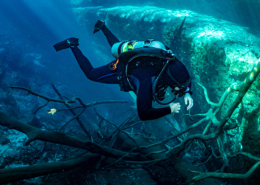Wildlife Life Rules: The Do’s and Don’ts with Aquatic Creatures
By Lauren Kieren
When I was asked to write an article on “the do’s and don’ts with aquatic creatures,” I thought to myself… Sure, that’s easy. The entire piece can be summed up like this: You can hurt it; it can hurt you; don’t touch it.
It really is that simple. However, I understand that may not be the most informative approach to this topic so I’ll give it another shot!
When we descend below the surface, we’re venturing into a completely new world. We’re weightless, gliding through the water, often observing the beautiful marine life swimming along reefs, wrecks, rivers and springs.
We are a guest in this alien environment.
We are there for the simple pleasure of experiencing a different world that does not belong to us; it belongs to the creatures that live in it. Like any respectable guest, we should be courteous and considerate, not create messes, break things or hurt those who live there. Here are a few reasons why…
You can hurt it
Most aquatic creatures and coral have a mucous lining that protects them and keeps them healthy. If we harm that protective lining, we expose them to risk, infections and diseases.
It can hurt you
The reality for aquatic creatures is that they are either the catch or the prey. Since this is the way their world works, they have built in defense mechanisms to protect them from being the catch of the day.
These defense mechanisms come in many forms such as spines, sharp fins and certainly sharper teeth. Some creatures are also packing major heat in the form of poisonous chemicals in their spines such as lion fish, rock fish and scorpion fish.
If you get handsy with aquatic creatures, understand if you get cut or stung – you are exposing yourself to not only a painful experience but also bacteria present in the water that can make your healing process extremely difficult. In addition, you’ve stressed the aquatic creature and likely changed its natural behavior to avoid humans in the future.
The bottom is off limits
Whether you’re diving a reef, wreck, river, spring, etc., it is extremely important to remember the bottom is off limits because it is the home for a lot of aquatic creatures, even if you can’t see them.
Kneeling or laying on the bottom, even if it looks like a clear sandy area, can destroy the home of an aquatic creature such as garden eels, jaw fish, various crustaceans, isopods and more. Touching or bouncing off the coral can destroy it after it has taken years to form and may never return back to its original state.
I will never forget a dive where I saw a lettuce sea slug knocked off the coral, tossed up into the water column and spun in a spiral motion back down after a diver simply swam near it. The diver didn’t touch or kick the bottom but they were not aware that their finning technique was disrupting the environment and creatures present.
Being in control of your hands and feet while swimming is crucial to avoid disrupting the environment. Just because you’re off the bottom, does not mean you aren’t interfering with it. Make sure the thrust of your fins is pushing the water up and behind you versus down to the bottom.
Lastly, always remember, you are a guest while visiting the underwater world. Look but don’t touch; be courteous and considerate, do not create messes, break things or hurt those who live there.










Laisser un commentaire
Rejoindre la discussion?N’hésitez pas à contribuer !